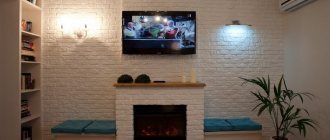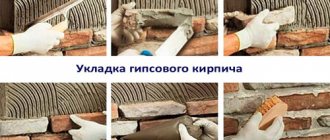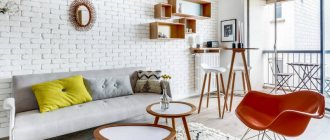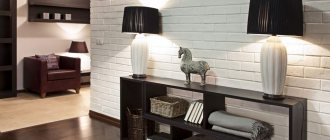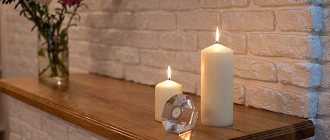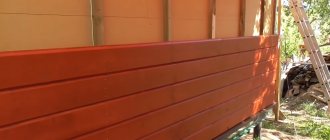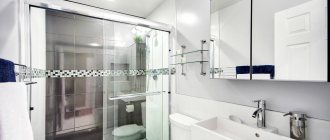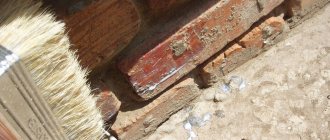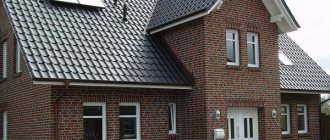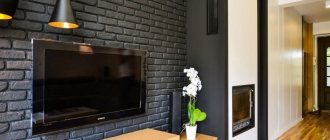Depending on the material used in the construction of the house, sooner or later the need for facade finishing arises in order to protect the enclosing structures and increase decorativeness. There are a lot of transformation options, depending on the initial data, the financial capabilities of the owners and their preferences. One of the relatively recently appeared facade materials, which our craftsmen have already tried, is flexible brick. Let's figure out what it is and how it works with the help of FORUMHOUSE users.
- What kind of material is flexible brick?
- Scope of application, characteristics.
- Installation.
- Experience of our craftsmen.
Features of the material
Flexible tiles, which imitate brick in appearance, are considered an excellent choice not only for external cladding, but also for interior decoration. It has numerous positive parameters and a beautiful appearance. Installation is simple, so every owner of the premises has the opportunity to do the work with their own hands. The tiles are easy to lay not only on flat surfaces, but also in corners.
It is produced in the form of individual tiles, which have standard sizes. They are thin and flat. The outer coating accurately imitates the appearance of brick. In the production process, polymer-sand solutions are used, which contain acrylic, pigments and sand. Therefore, not only an attractive finish is guaranteed, but also excellent protection of surfaces from various mechanical influences.
The material is most often used in the hallway or corridor, in the kitchen or balcony. An excellent solution is its use for cladding various fireplaces, columns or other massive and original decorative structures.
It is allowed to use brick-like tiles not only for completely covering the surface, but also for point fixation and creating original accents. It is produced in different colors, and during the finishing process you can use not only one color, but also combine different shades, creating an original design.
Is it worth using on the facade?
The described polymer finishing building material has a number of advantages that allow builders to use it when finishing facades. The flexibility of the building elements makes it possible to cover uneven or rounded walls. A variety of colors will create a stylish decorative solution that will blend with neighboring buildings and the landscape. Good physical properties will successfully replace brick.
The universal features of the material allow it to be used in various design projects. It is possible to cladding with flexible elements not only on the façade and walls; the following building materials are used to decorate:
- fireplaces;
- window and door bays;
- corners and protruding architectural elements;
- piers;
- flights of stairs.
Advantages and disadvantages
Flexible tiles have the following positive and negative parameters.
| pros | Minuses |
| Resistance to numerous mechanical influences | It is not allowed to use caustic agents or alkalis during the care process. |
| Ecological cleanliness | The process of cleaning the coating from contaminants is difficult |
| Resistant to fire and steam | Since a material that imitates brick is chosen, such a coating does not always fit into modern or unusual interior styles. |
| Attractive appearance | Some manufacturers set high prices for goods |
| Resistance to constant exposure to ultraviolet radiation or other environmental factors | If you purchase elements from different batches, they may differ slightly from each other, which will be clearly visible on the coating |
| Long service life | There are unscrupulous manufacturers on the market offering low-quality material. |
| High temperature resistance | — |
| Ease of cutting | — |
| There is no need to use expensive and complex corner elements during installation | — |
| Ease and speed of installation | — |
| Affordable price | — |
| The parts are highly elastic, so they can be used for different substrates | — |
The material has a lot of advantages, but there are few disadvantages. Therefore, it is considered an excellent choice for interior decoration of any room, however, it is important to make sure in advance that the brick-imitation coating will fit well into the style of the room.
Types of flexible brick-like tiles for interior decoration
This material is presented on the market in the following varieties, which differ in markings:
- RF;
- WF;
- NF.
These types differ in size, so when choosing a material, the required dimensions of the tiles are taken into account.
Modern manufacturers produce a large number of such tiles, which differ in color, so it is possible to choose a material that imitates brick, which will have a suitable shade for a particular room. Some factories even offer customers the opportunity to order material of a certain color, however, the cost in this case will be much higher, and there are also certain restrictions on the quantity of goods produced.
Different types of tiles differ not only in size and color, but also in cost, thickness, parameters and appearance. Therefore, the choice must be reasonable and correct.
How to choose the right facing material
If you decide that a specific part of the room or the entire room will be tiled with flexible tiles that imitate brick, then it is important to choose it wisely. For this, the following factors are taken into account:
- appearance - it should ideally suit the room in which finishing work is planned. It is important to decide in advance on the concept and style of the interior so as not to spoil it with tiles that imitate brick;
- color of the material - this factor is important, but at the same time it is necessary to focus on other shades present in the interior;
- quality of the material - the finish will be attractive and durable only if high-quality tiles are used, which must be reliable and resistant to various factors. Before purchasing, it is recommended to carefully study the documentation from the manufacturer to learn about the main characteristics of the material;
- cost - it is important for many buyers, since tiles are available in a wide range of prices;
- composition of the material - since it is planned to carry out work in a residential area, it is extremely important that the structure is completely free of harmful or dangerous components.
After choosing the optimal material, the actual finishing of the room begins. To do this, it is important to decide how exactly the tile will be used, since it can be used in different ways.
Scope of application, characteristics
This is a universal finish intended for interior work and cladding of facades, completely or in accent areas - entrance groups, balconies, columns, around window and door openings. Almost any area where it is necessary to achieve the effect of brickwork or stone cladding, without weighing down the base. Particularly flexible finishing is relevant for complex shapes, as the tile bends and rolls into a cylinder.
The material can be used for lining fireplaces and furnaces if their surface does not heat above +60⁰С; if the temperature is higher, an insulation layer is needed.
Since flexible stone is designed for external use, it has the following characteristics:
- impact resistance - the tile is soft and will not break if accidentally touched, but you can break anything on purpose;
- wear resistance - not afraid of UV radiation, does not erode, does not wear out;
- moisture resistance - flexible cladding practically does not absorb water;
- frost resistance - depends on the specific brand, but not less than 35 cycles.
As for durability, the material is promised a long service life, but it cannot boast of a long service life. Although it is logical to assume that marble chips or coarse quartz sand based on acrylic will last no less than soft tiles, and this is from 10 years. Not the longest period, but quite acceptable for façade systems of this type.
Material use options
Tiles can be used on a variety of surfaces and have also been used in different operating conditions. Therefore, before purchasing, you should decide on the planned work. The material is used for the following purposes:
- wall cladding, most often in rooms where unusual motifs and styles are used;
- it is allowed to perform work even in a bathroom or other room in which there is a high humidity level;
- finishing of various curved and complex structures, which include arches or fireplaces, columns or steps of stairs;
- Often the finishing of even kitchen facades is formed, which ensures a very beautiful and unusual set that fits perfectly into the interior.
Thus, flexible material is considered an excellent solution for the walls of various rooms, and can also be used for a variety of structures that act as decorative elements in rooms.
Flexible stone decor
Soft stone finishing is not the only way to use the material. Designers have long come up with several ways to use products to diversify interior decorations.
With the help of plastic slabs you can give new life to flower beds and decorative elements of landscape design. It is enough to simply paste over the products with a material of a suitable texture.
The most popular decor using soft stone is lampshades and shades for lamps. The finishing material perfectly transmits light and creates a warm, diffused flow of rays. “Stone” lamps look amazing in classic interiors, modern, loft, and eco styles.
You can decorate niches in the walls with decorative stone. Against such a background, paintings on natural canvases, figurines, porcelain figurines, and pots with plants will “bloom.”
Lamp with flexible stone design
Flexible stone sauna counter design
Laying features
Finishing with flexible tiles that imitate brickwork is considered a fairly simple process that can be easily performed by anyone. This does not require the use of specific or expensive tools.
It is necessary to choose the right glue specifically designed for working with this material.
The glue is available in the form of a dry mixture or a ready-made composition. In the first case, you will have to mix the mixture with the optimal amount of water in accordance with the available instructions. In the second, you can begin direct installation work immediately after opening the container with glue.
The installation process itself is divided into the following stages:
- The wall is being prepared - it must be smooth and perfectly clean. If there are transitions and irregularities, they are eliminated with a standard leveling solution. Next, the wall is covered with a special primer that contains antiseptics. This layer increases adhesion between brick tiles and the base;
Surface marking
- the room temperature should not be set below 5 degrees, as this will negatively affect the quality of gluing;
- markings are applied to the wall;
- The prepared adhesive solution is distributed on the base, and its thickness should be approximately 2 mm. It is applied with a regular spatula, but it is recommended to distribute it over the surface with a notched spatula, which ensures the creation of a perfectly even layer;
Applying glue
- gluing of tiles in successive rows begins. It is recommended to start the first row with a whole tile, and the next with half of it. This allows you to get an interesting and beautiful result of the work. Flexible tiles are cut very simply, using standard sharp scissors. During work, it is important to ensure that the rows are even and beautiful, and that exactly the same distance is left between all the tiles. The seams must be identical in thickness, otherwise the entire finish will not be attractive. In the corners, the elements are easily bent, so a complete coating is formed. This process is performed for both external and internal corners;
Tile installation
If necessary, the size of the tiles can be changed
- After creating the coating, the remaining adhesive solution is leveled in the seams, for which an ordinary thin brush is used, which is pre-wetted with water. There is no need to seal the seams with grout, which is considered an advantage of the material, since there is no need to spend additional money for this purpose.
Using a brush, remove the excess layer of glue.
Thus, the process of laying tiles imitating brick is considered understandable and therefore accessible to everyone.
Original ways to create imitation
Agree, buying a high-quality product that will skillfully imitate brick will cost the buyer a decent amount of money. Is there really no way to make such a solution for your interior more accessible? Of course have! Nothing is impossible for a person, and they came up with various original methods, which we will talk about in this chapter.
Let's consider several options in which we will use different mixtures. You can get the job done by mixing gypsum plaster with tile cement adhesive, using clear or decorative plaster or thick paint.
Option 1
Step 1 – applying plaster to the wall surface.
The first option is very simple to implement, but the work itself is quite painstaking and time-consuming, but the texture turns out to be very expressive. So, we dilute the plaster mixture and apply it with a spatula to the wall in a layer of 1-2 cm - it depends on the depth of the relief that you want to achieve. The mixture must be applied unevenly so that the result resembles natural stone.
Applying plaster to the wall surface
Step 2 – extruding the texture.
Then we take a deep rectangular mold, moisten it in water so that it does not stick to the plaster and begin making impressions, thereby creating the desired imitation.
Extruding texture
Prices for popular types of plaster
Plaster
Step 3 – shading.
Take a wet paint brush and start smoothing out the edges. The “brick” will begin to resemble natural stone.
The finished wall needs to be sanded and painted in the desired color. An excellent result for the most modest investment. If you use the mixture with tile adhesive, it will be very durable.
Shading
Option 2
Step 1 – stick the stencil.
The base is processed and then painted white. Then a thin checkerboard-shaped masking tape is applied to the wall. This way we get a stencil that will help to very quickly form seams on the surface.
Stencil sticker
Step 2 – painting.
Now we can start painting the wall with dark, thick paint. After walking a few squares, we partially remove the stencil, and in its place the perfect brick texture will remain.
Of course, the result is not very voluminous, but for interior decoration this is quite enough. And given the simplicity and speed of the method, it becomes a priority for many.
Painting
If you want to get a more realistic effect, then use a thin layer of plaster instead of paint - the tape is removed when the mixture has set a little.
Option 3
Step 1 – applying plaster.
We start by applying gypsum plaster to the base. Its surface must be made as smooth and even as possible, so beacons are mandatory.
Applying plaster
Step 2 – cutting the relief.
After the plaster has set a little, take the rule, apply it to the wall with a certain step and use a wide screwdriver to cut the seams. It turns out very beautiful and impressive.
This work is very painstaking, but the appearance of the wall will be on par, the treasure will have smooth edges.
Relief cutting
As you can see, there are many ways to decorate your home with brickwork. Choose the best option for yourself, and go ahead - you will definitely succeed.
Coating care rules
The resulting coating does not require specific or complex care, and is therefore considered easy to use. If for some reason the integrity of part of the coating is compromised, then some elements are easily removed and new tiles are glued in their place.
It is possible to create a coating even in rooms where the temperature is high, since this factor does not affect it and also does not lead to the release of any harmful components. You can clean the coating from various contaminants with a regular wet cloth, however, it is not recommended to apply too much force, since such an action can lead to deformation of some tiles.
Thus, for interior decoration, tiles that imitate brickwork are considered an excellent choice for every property owner. They come in numerous forms, are reasonably priced, and are easy to use. They create a beautiful and durable coating that fits perfectly into many interior styles.
Reviews
It's time to tackle the facade of your country cottage. The volume of my walls is quite decent, since the house is two storeys. To make it less costly, I decided to purchase flexible bricks. What can I say, at a fairly low cost, I was pleased with the result - it looks very beautiful. I did the work myself; the material fits easily onto the rounded wall elements.
Kirill, Moscow
I needed to restore an old building, read numerous construction forums and eventually bought flexible bricks. For installation, I hired a team of craftsmen, and the result was a surface that resembles brickwork. When my comrades saw the house, they decided that the facade was covered with façade brick.
Oleg, St. Petersburg
Consumers perceive flexible facade bricks with caution, since this cladding option is considered unconventional. The price of products and work is not budget, but consumers who used this technology were satisfied with the result.
Victor
